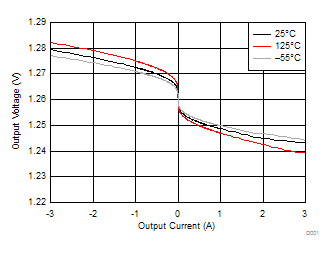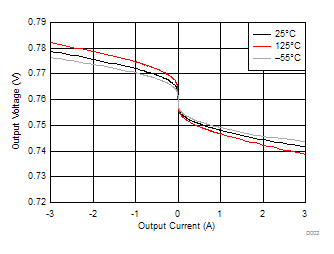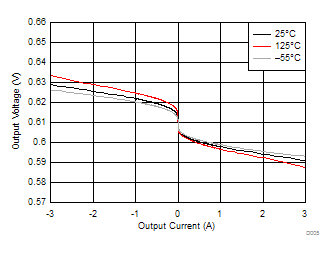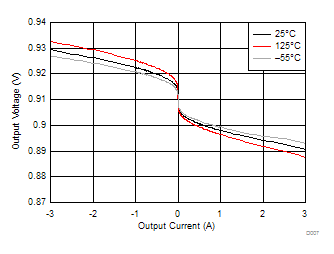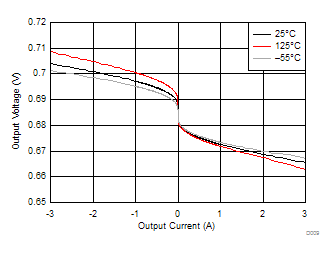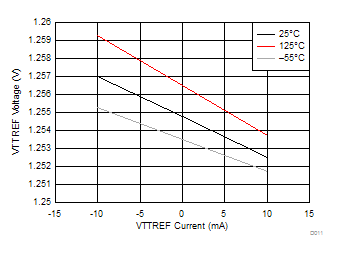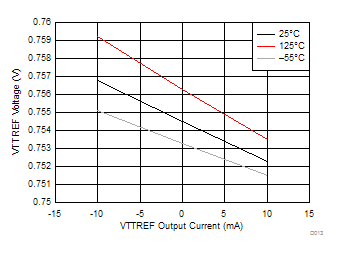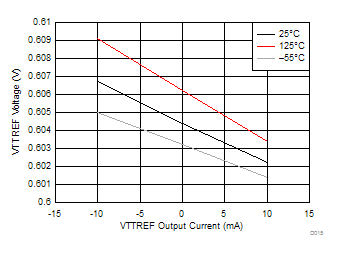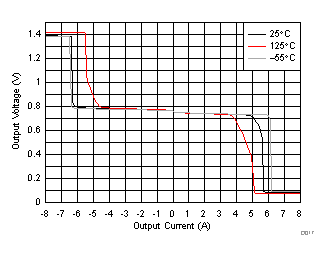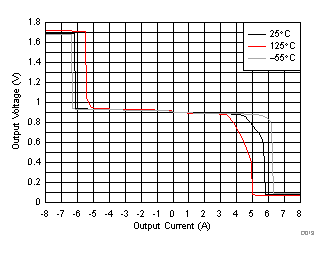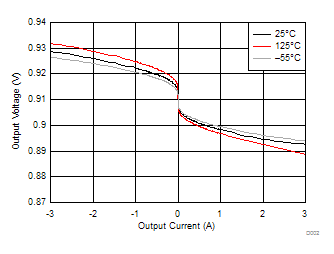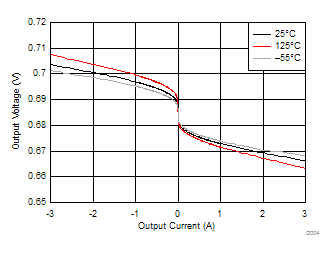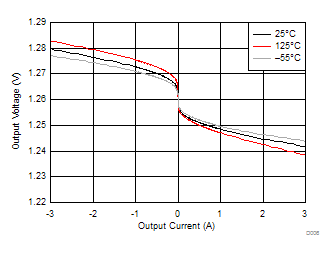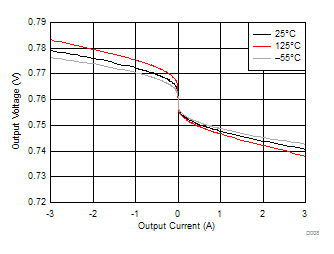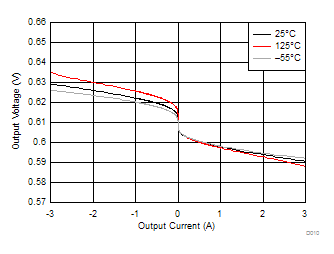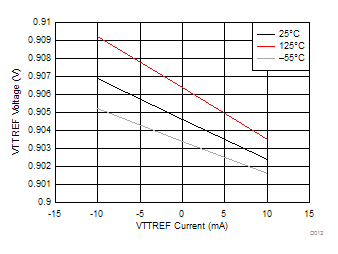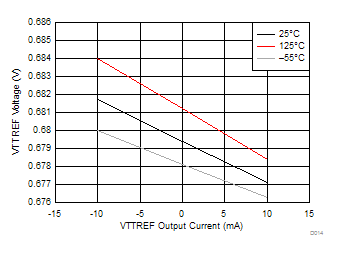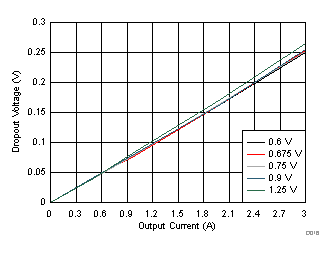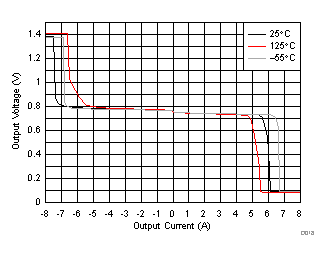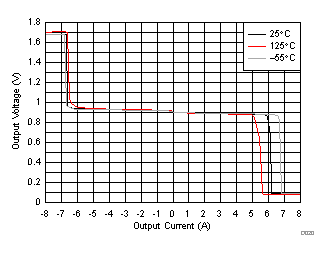| SUPPLY CURRENT |
| IIN /IVDD |
Supply current |
V EN = 3.3 V, No Load |
|
18 |
30 |
mA |
| IVDD(SDN) |
Shutdown current |
V EN = 0 V, VDDQSNS = 0, No Load |
|
3 |
5 |
mA |
| V EN = 0 V, VDDQSNS > 0.78 V, No Load |
|
6.5 |
8 |
| ILDOIN |
Supply current of VLDOIN |
V EN = 3.3 V, No Load |
|
575 |
1200 |
μA |
| ILDOIN(SDN) |
Shutdown current of VLDOIN |
V EN = 0 V, No Load |
|
50 |
100 |
μA |
| INPUT CURRENT |
| IVDDQsns |
Input current, VDDQsns |
V EN = 3.3 V |
|
4 |
6 |
μA |
| VO / VTT OUTPUT |
| VVOSNS/VTTSNS |
Output DC voltage, VO |
V LDOIN = 2.5 V, VVTTREF = 1.25 V (DDR1), I O = 0 A |
|
1.25 |
|
V |
| –6 |
|
6 |
mV |
| V LDOIN = 1.8 V, VVTTREF = 0.9 V (DDR2), I O = 0 A |
|
0.9 |
|
V |
| –6 |
|
6 |
mV |
| V LDOIN = 1.5 V, VVTTREF = 0.75 V (DDR3), I O = 0 A |
|
0.75 |
|
V |
| –6 |
|
6 |
mV |
| V LDOIN = 1.35 V, VVTTREF = 0.675 V (DDR3L), I O = 0 A |
|
0.675 |
|
V |
| –6 |
|
6 |
mV |
| V LDOIN = 1.20 V, VVTTREF = 0.60 V (DDR4), I O = 0 A |
|
0.60 |
|
V |
| –6 |
|
6 |
mV |
| VLODIN – VTT (3) |
VLODIN > VTT |
VIN / VDD = 2.95 V, VVDDQSNS = 2.50 V, V TT = VVTTREF – 50 mV (DDR1), I O = 0.5 A |
|
50 |
230 |
mV |
| VIN / VDD = 2.95 V, VVDDQSNS = 2.50 V, V TT = VVTTREF – 50 mV (DDR1), I O = 1 A |
|
101 |
300 |
| VIN / VDD = 2.95 V, VVDDQSNS = 2.50 V, V TT = VVTTREF – 50 mV (DDR1), I O = 2.0 A(2) |
|
209 |
400 |
| VIN / VDD = 2.375 V, VVDDQSNS = 1.80 V, V TT = VVTTREF – 50 mV (DDR2), I O = 0.5 A(2) |
|
54 |
230 |
| VIN / VDD = 2.375 V, VVDDQSNS = 1.80 V, V TT = VVTTREF – 50 mV (DDR2), I O = 1 A(2) |
|
108 |
300 |
| VIN / VDD = 2.375 V, VVDDQSNS = 1.80 V, V TT = VVTTREF – 50 mV (DDR2), I O = 2.0 A(2) |
|
228 |
400 |
| VIN / VDD = 2.375 V, VVDDQSNS = 1.50 V, V TT = VVTTREF – 50 mV (DDR3), I O = 0.5 A |
|
52 |
230 |
| VIN / VDD = 2.375 V, VVDDQSNS = 1.50 V, V TT = VVTTREF – 50 mV (DDR3), I O = 1 A |
|
104 |
300 |
| VIN / VDD = 2.375 V, VVDDQSNS = 1.50 V, V TT = VVTTREF – 50 mV (DDR3), I O = 2.0 A(2) |
|
216 |
400 |
| VIN / VDD = 2.375 V, VVDDQSNS = 1.35 V, V TT = VVTTREF – 50 mV (DDR3L), I O = 0.5 A |
|
50 |
230 |
| VIN / VDD = 2.375 V, VVDDQSNS = 1.35 V, V TT = VVTTREF – 50 mV (DDR3L), I O = 1 A |
|
102 |
300 |
| VIN / VDD = 2.375 V, VVDDQSNS = 1.35 V, V TT = VVTTREF – 50 mV (DDR3L), I O = 2.0 A(2) |
|
212 |
400 |
| VIN / VDD = 2.375 V, VVDDQSNS = 1.20 V, V TT = VVTTREF – 50 mV (DDR4), I O = 0.5 A |
|
50 |
230 |
| VIN / VDD = 2.375 V, VVDDQSNS = 1.20 V, V TT = VVTTREF – 50 mV (DDR4), I O = 1 A |
|
102 |
300 |
| VIN / VDD = 2.375 V, VVDDQSNS = 1.20 V, V TT = VVTTREF – 50 mV (DDR4), I O = 2.0 A(2) |
|
210 |
400 |
| VVOTOL/VTTTOL |
Output voltage tolerance to VVTTREF |
I VO = –3 A, across VIN voltage range(2) |
12 |
25 |
34 |
mV |
| I VO = 3 A, across VIN voltage range(2) |
-34 |
–25 |
-12 |
| IVOSRCL |
VO/VTT source current limit |
With reference to V VTTREF, VVTTSNS = 90% × V VTTREF |
3.25 |
|
8 |
A |
| IVOSNCL |
VO/VTT sink current limit |
With reference to V VTTREF, VVTTSNS = 110% × V VTTREF |
3.5 |
|
5.5 |
A |
| RDSCHRG |
Discharge impedance, Ω |
V DDQSNS = 0 V, VVO = 0.3 V, V EN = 0 V, TA = 25°C |
|
18 |
25 |
Ω |
| POWERGOOD COMPARATOR |
|
| VTH(PG) |
VO/VTT PGOOD threshold |
PGOOD window lower threshold with respect to VVTTREF |
–23.5% |
–20% |
–17.5% |
|
| PGOOD window upper threshold with respect to VVTTREF |
17.5% |
20% |
23.5% |
| PGOOD hysteresis |
|
5% |
|
| TPGSTUPDLY |
PGOOD startup delay |
Startup rising edge, VOSNS within 15% of VVTTREF |
|
2 |
|
ms |
| VPGOODLOW |
Output low voltage |
I SINK = 4 mA |
|
|
0.4 |
V |
| TPBADDLY |
PGOOD bad delay |
V OSNS is outside of the ±20% PGOOD window |
|
1 |
|
μs |
| IPGOODLK |
Leakage current |
V OSNS = VREFIN (PGOOD high impedance),
PGOOD = VIN + 0.2 V |
|
|
1 |
μA |
| VDDQSNS AND VVTTREF OUTPUT |
|
| VDDQSNS |
VDDQSNS voltage range |
|
1.0 |
|
2.80 |
V |
| VDDQSNS_UVLO |
VDDQSNS undervoltage lockout |
V DDQSNS rising |
|
780 |
|
mV |
| VDDQSNSUVHYS |
VDDQSNS undervoltage lockout hysteresis |
|
|
20 |
|
mV |
| V VTTREF |
VVTTREF voltage |
|
|
VDDQSNS / 2 |
|
V |
| V VTTREF |
V VTTREF voltage tolerance to VVDDQSNS |
–10 mA < I VTTREF <10 mA, VVDDQSNS = 2.5 V |
–15 |
|
15 |
mV |
| –10 mA <I VTTREF <10 mA, VVDDQSNS = 1.8 V |
–15 |
|
15 |
| –10 mA <I VTTREF <10 mA, VVDDQSNS = 1.5 V |
–15 |
|
15 |
| –10 mA <I VTTREF <10 mA, VVDDQSNS = 1.35 V |
–15 |
|
15 |
| –10 mA <I VTTREF <10 mA, VVDDQSNS = 1.2 V |
–15 |
|
15 |
|
| I VTTREFSRCL |
V VTTREF source current limit |
VTTREF = 0 V |
10 |
40 |
|
mA |
| I VTTREFSNCCL |
V VTTREF sink current limit |
VTTREF = 0 V |
6 |
40 |
|
mA |
| I VTTREFDIS |
VVTTREF discharge current |
EN = 0 V, V DDQSNS = 0 V, VVTTREF = 0.5 V |
|
1.3 |
|
mA |
| UVLO/EN LOGIC THRESHOLD |
|
| VVINUVVIN |
UVLO threshold |
Wake up, T A = 25°C |
|
2.18 |
2.25 |
V |
| Hysteresis |
|
50 |
|
mV |
| VENIH |
High-level input voltage |
Enable |
1.7 |
|
|
V |
| VENIL |
Low-level input voltage |
Enable |
|
|
0.3 |
| VENYST |
Hysteresis voltage |
Enable |
|
0.5 |
|
| IENLEAK |
Logic input leakage current |
EN, T A = 25°C |
–1 |
|
1 |
μA |
| THERMAL SHUTDOWN |
|
| TSON |
Thermal shutdown threshold (1) |
Shutdown temperature |
|
210 |
|
°C |
| Hysteresis |
|
12 |
|
